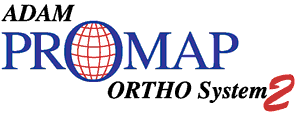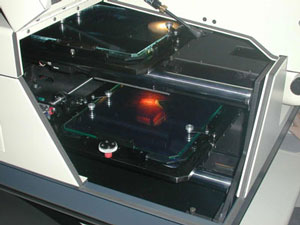
The ADAM PROMAP ORTHO System 2 is a precision photogrammetric scanner and orthophoto rectification upgrade kit that can be installed into any ADAM Technology PROMAP. With this kit installed the PROMAP can simultaneously scan and orthorectify images at resolutions of up to 8 microns per pixel with a geometric accuracy of better than 3 microns RMS. Download a brochure now. We are confident that the Promap Ortho System 2 offers a unique 'hybrid' solution for the mapping industry. View our Promap Ortho System comparison to softcopy systems and see for yourself.
- Cost-effective orthophoto production
- Ortho rectification during scanning in one operation
- High speed scanning
- Optical scan pixel size adjustable by the operator to any size between 8 and 30 microns
- New ORTHO System 2.1a Software
includes:
- Improved image capture quality with adjustable settings to maximise output.
- New on-the-fly colour correction facility which can also be applied to existing scans.
- Intelligent "Dust removing" Calibration Software
- Increased Accuracy through the use of improved Geometric Calibration software.
- Support for overlaying ADAM 3DD 3.1 vector data and sheet files.
 |
| Figure 1. ORTHO System 2 system inside a PROMAP |
The ORTHO System 2 is unique in that the scanning and orthophoto rectification is done in a single step. Only the final ortho image is ever stored! There is no need to scan and store all the intermediate image files that a softcopy system would require, nor to scan areas of the image that will not be used in the final orthophoto. However, if you do need to produce digital images for a softcopy system, the ORTHO System 2 is more than capable. The optical pixel size can easily be set by the user to any value between 8 and 30 microns within minutes, and the software can also resample to any pixel size you require.
Improved functionality ensures that the ORTHO System 2 meets the needs of a mapping organisation looking to maximise productivity. The ORTHO System 2 is an Analytical Stereoplotter, Photogrammetric Scanner, and Orthophoto Generator in the one instrument. This combines the best of both worlds -- orthophoto generation and the no-compromise data capturing abilities that only a high-quality analytical stereoplotter can provide.
The integration of analytical stereoplotter and orthophoto "machine" ensures that only minimal operator training is required. With the ORTHO System 2 you maintain control over your work-flow and over the quality of your work. On the one instrument you can easily and efficiently produce DTMs from the original diapositives and then scan and create the orthorectified images within minutes, at the pixel size you desire.
Data Transfer
The ORTHO System 2 supports the following file formats for DTM/DEM data import:
- ADAM 3DD MAF
- AUTOCAD DXF
- ASCII XYZ
The ORTHO System 2 also comes complete with a full image editing package that supports all major image formats including TIFF and JPEG, allowing you to use the generated images with any 3rd party products. In addition, the ORTHO System 2 integrates with ADAM 3DD 3.1 allowing you to overlay symbolised vector data generated by 3DD over the top of the scanned ortho image for printing to any Windows-supported printer, including Postscript printers.
Performance
Model area scans
One of the unique features of the ADAM PROMAP ORTHO System 2 is the fact that the complete orthorectification occurs during scanning. On a softcopy system, entire images are scanned and stored, requiring nearly 2.4GB of storage each at 8 microns, or close to 700MB at a more typical 15 microns. Later, pairs of these images are loaded for observations (DTM generation, for example), and then portions used for the final orthophoto.
The ADAM PROMAP ORTHO System 2 works differently. The PROMAP is a first-order analytical stereoplotter that allows observations (such as the DTM) to be obtained directly from the highest-resolution medium available, the original diapositive. No scanning and transferring of images is required. Once the DTM has been captured, the operator only needs to scan that portion of the currently-loaded image that will be used in the final orthophoto. Typically this will amount to just 28% of the total area of a given diapositive (40% of the width and 70% of the height). As it is being scanned, the ORTHO System software orthorectifies it on-the-fly, with only the final orthorectified image being written to disk. This results in tremendous savings in both time and storage requirements, and makes the following timings even more attractive when they are compared with those of dedicated photogrammetric scanners:
| Pixel Size | File Size | Scanning Times MM:SS |
|
|---|---|---|---|
| 533MHz Celeron | 1GHz Athlon | ||
| 30 microns | 47 MB | 2:21 | 1:56 |
| 25 microns | 68 MB | 3:34 | 2:19 |
| 20 microns | 106 MB | 5:33 | 3:42 |
| 15 microns | 188 MB | 9:07 | 5:22 |
| 8 microns | 662 MB | 29:51 | 15:40 |
Full image scans
Of course, the ADAM PROMAP ORTHO System 2 can also be used as a photogrammetric scanner if required, and performs exceptionally in that role as well:
| Pixel Size | File Size | Scanning Times MM:SS |
||
|---|---|---|---|---|
| 533MHz Celeron | 1GHz Pentium III | 1GHz Athlon | ||
| 30 microns | 168 MB | 8:15 | ~9:00 | 6:09 |
| 25 microns | 242 MB | 12:21 | N/A | 8:23 |
| 20 microns | 378 MB | 17:57 | N/A | 11:11 |
| 15 microns | 673 MB | 30:37 | ~22:00 | 17:05 |
Notes:
-
"Model area" is assumed to be 28% (40% of the width and 70% of the height) of the total area of a 230mm x 230mm diapositive. This would be the normal area of an image scanned for an orthophoto. "Full image" is an entire 230mm x 230mm diapositive, and would typically be used for other purposes.
-
"Pixel Size" refers to both optical pixel size and output pixel size. The software can resample the images to any specified output pixel size.
-
All times include full orthorectification and gamma-correction of the image data and writing of the image data to disk.
-
Pentium III times supplied by a customer and are approximate only.
Improvements over the original ORTHO System
| Speed | ORTHO System 2 is three to four times faster than the original System. The increases in speed of scanning and Ortho creation are due to:
|
| Features |
|